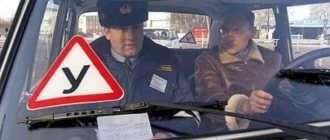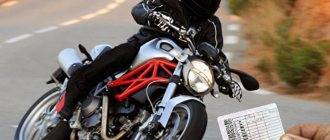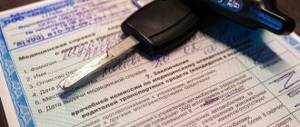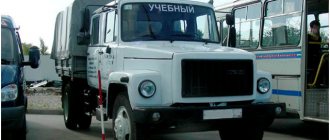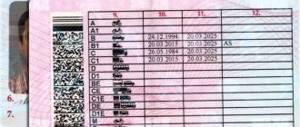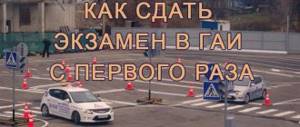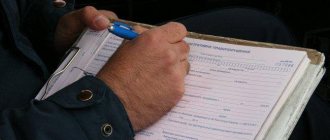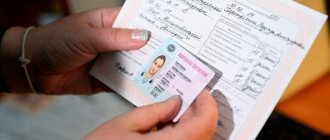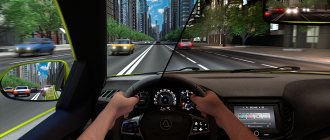Ticket 11 question 14 31% wrong
In what case do you have the right to pass the intersection first?
Only when driving straight When driving straight, left and in the opposite direction When driving straight and left
The intersection is equal. Drivers are guided by the “right hand rule”, i.e. whoever has an obstacle on the right concedes. There is an obstacle on the right side of the driver of a car. You pass the intersection first when driving straight and to the left. When turning, there will be an obstacle on your right. (Clause 13.11 of the Traffic Regulations). The correct answer is “When moving straight and to the left”
Topics of the question (solve them if you have any difficulties in this matter):
- Driving through intersections
Hint Further Discuss (8)
Question No. 12 (63% incorrect answers)
Are you allowed to transport cargo using the shown method during daylight hours if the width of the cargo exceeds 2.55 meters?
1. Allowed in any case.
2. Permitted in accordance with special permits and regulations.
3. Permitted provided that the cargo is marked with identification marks “Large cargo”.
4. Prohibited.
Explanation of the problem: Since in the shown situation when transporting cargo, the width of the cargo exceeds 2.55 meters, the driver of a passenger car is allowed to transport such cargo only in accordance with special permits and rules.
Ticket 40 question 10 32% wrong
Which driver took the correct position in the lane?
Only the driver of a motorcycle occupying the right position in the lane Only the driver of the moped occupying the left position in the lane None of the drivers Both
Moped drivers must move along the right edge of the roadway in a single file. Motorcyclists can choose any lane to drive in a populated area, as long as a safe interval is ensured. The Rules do not prohibit them from moving along a lane in two rows. (Clause 9.4, 24.7 of the Traffic Regulations). The correct answer is “Only the driver of a motorcycle occupying the right position in the traffic lane.”
Topics of the question (solve them if you have any difficulties in this matter):
- Location of vehicles on the roadway
Hint Further Discuss (48)
Question No. 11 (63% incorrect answers)
Are you allowed to stop on the shown section of the road in a populated area for reasons not related to picking up (dropping off) passengers?
1. Prohibited.
2. Allowed from any side.
3. Allowed only on the right side near the sidewalk.
Explanation of the problem: According to the Rules, stopping and parking are permitted on the right shoulder in the direction of travel, and if there is no shoulder or it is impossible to stop on it, at the edge of the roadway parallel to it, with the exception of those places where road signs or road markings allow different location of vehicles (only stopping vehicles is allowed outside populated areas). In a populated area, stopping is allowed at the left edge of the roadway parallel to it on a road with one lane for each direction without tram tracks in the middle. Thus, in the situation shown, you are allowed to stop on either side. It should be remembered that stopping on the left to board (disembark) passengers in the situation shown is prohibited, because in accordance with clause 23.1 of the traffic rules, in the absence of a landing platform, passengers are required to board (disembark) from the sidewalk or curb, which are also absent in the situation shown.
Ticket 8 question 3 31% wrong
Which of the following signs prohibit turning left?
Only A A and B A and B All
At an intersection in front of which there is a sign “A” - 5.13.1 “Entering a road with a lane for route vehicles,” it is prohibited for other vehicles to turn left. Prohibits turning to all types of vehicles and sign “B” - 6.3.1 “Place for a U-turn.” Among the signs depicted, you should pay attention to sign “B” - 3.19 “Turning is prohibited”, which, on the contrary, does not prohibit turning left. ("Road signs"). The correct answer is “A and B”
Topics of the question (solve them if you have any difficulties in this matter):
- Road signs
Hint Further Discuss (13)
Question No. 5 (67% incorrect answers)
On which of the following road sections is overtaking not prohibited?
1. When driving on a main road at an unmarked but controlled intersection.
2. When driving on a secondary road at an unmarked and unregulated intersection.
3. When driving on an equivalent road at an intersection marked with a road sign “Intersection of equivalent roads.”
4. Overtaking is prohibited at all listed intersections.
5. At all listed intersections, overtaking is not prohibited.
Explanation of the problem: According to the Rules, overtaking is prohibited, in particular, at marked and (or) controlled intersections. In accordance with the term, a “designated intersection” is an intersection in front of which a priority road sign(s) is installed on a given road. Considering the fact that the intersection in front of which the priority road sign “Intersection of Equivalent Roads” is installed is designated, overtaking at it is prohibited. Thus, in accordance with the proposed answer options, overtaking is not prohibited when driving on a secondary road at an unmarked and uncontrolled intersection.
Ticket 34 question 17 35% wrong
In a tunnel with artificial lighting the following must be included:
Low beam headlights or daytime running lights Low beam headlights or side lights Low beam or high beam headlights
Regardless of the illumination of the tunnel, when entering it, high or low beam headlights must be turned on. (Clause 19.1 of the Traffic Regulations). The correct answer is “Low or high beam headlights”
Topics of the question (solve them if you have any difficulties in this matter):
- Use of external lighting devices and sound signals
Hint Further Discuss
Ticket 36 question 13 31% wrong
You intend to turn right. Your actions?
Wait for another signal from the traffic controller Pass the intersection first Give way to a car making a U-turn
From the side of the traffic controller's outstretched right hand, trackless vehicles are only allowed to move to the right. At the same time, the turning car, guided by the “right-hand rule,” gives way to you. (Clause 6.10 of the Traffic Regulations). The correct answer is “Go through the intersection first.”
Topics of the question (solve them if you have any difficulties in this matter):
- Traffic lights and traffic controller signals
- Driving through intersections
Hint Further Discuss (24)
Ticket 10 question 8 31% wrong
Which trajectory are you allowed to make a left turn?
For any of the above Only for B Only for A
Before turning left or right, the driver must take the extreme position on the roadway in advance. The road is one-way, leaving it is no exception. Therefore, you should make a left turn along trajectory “B”. (“Road signs”, paragraph 8.5 of traffic rules). The correct answer is “Only according to B”
Topics of the question (solve them if you have any difficulties in this matter):
- Start of movement, maneuvering
Hint Further Discuss (139)
Question No. 17 (62% incorrect answers)
Which of the following persons is not a road user?
1. Driver of an operational vehicle.
2. An employee of the Military Automotive Inspectorate in uniform when ensuring the movement of organized transport convoys, which include vehicles belonging to the Ministry of Defense.
3. Driver of a route vehicle.
4. A person trained to drive a power-driven vehicle.
5. All listed persons are road users.
Explanation of the problem: According to the term, “road user” is an individual located within the road (i.e. on the roadway, tram tracks, sidewalk, pedestrian and bicycle paths, dividing zone, dividing strip, railway crossing deck , roadside) in (on) a vehicle or outside it, with the exception of a traffic controller and an employee performing repair and other work on the road in the prescribed manner. In accordance with this, of the listed persons, only an employee of the Military Automotive Inspectorate in uniform is not a participant in traffic when ensuring the movement of organized transport convoys, which include vehicles belonging to the Ministry of Defense, because he is a traffic controller.
Ticket 27 question 13 31% wrong
What should you do when turning right?
Pass the intersection, giving way to the tram Pass the intersection first Stop and wait for another signal from the traffic controller
The intersection is controlled. From the left side, with such a gesture from the traffic controller, trackless vehicles are allowed to move in all directions. Trams move only “in the direction of the traffic controller’s hands.” In this situation, the tram cannot continue moving. Its driver will wait for the traffic controller's signal to change. You continue through the intersection, i.e. pass it first. (Clause 6.10 of the Traffic Regulations). The correct answer is “Go through the intersection first.”
Topics of the question (solve them if you have any difficulties in this matter):
- Traffic lights and traffic controller signals
- Driving through intersections
Hint Further Discuss (10)
Ticket 29 question 12 32% wrong
Which driver violated the stopping rules?
Only the driver of car B No one violated Both Only the driver of car A
Don't confuse stopping with parking. Stopping is prohibited directly at a railway crossing, the boundaries of which are barriers. Parking is prohibited directly at the railway crossing and closer than 50 m from it. The drivers stopped outside the railroad crossing without violating the rules. (Clause 12.4, 12.1 of traffic regulations). The correct answer is “No one violated”
Topics of the question (solve them if you have any difficulties in this matter):
- Stopping and parking
Hint Further Discuss (14)
Ticket 18 question 18 38% wrong
What administrative offenses in the field of traffic are punishable by compulsory labor?
For all the listed offenses For driving a vehicle by a driver who does not have the right to drive a vehicle (except for instructional driving) For driving a vehicle by a driver deprived of the right to drive vehicles For transferring control of a vehicle to a person who obviously does not have the right to drive (except for instructional driving ) or deprived of such right
Article 12.7 Part 2 of the Code of Administrative Offenses provides for administrative punishment for driving a vehicle by a driver deprived of the right to drive vehicles. The correct answer is “For driving a vehicle by a driver deprived of the right to drive vehicles.”
Topics of the question (solve them if you have any difficulties in this matter):
- Driver's responsibility
Hint Further Discuss (3)
Question No. 15 (62% incorrect answers)
What is the object of compulsory insurance for a vehicle owner?
1. Vehicle.
2. Civil liability of the vehicle owner.
3. Administrative responsibility of the driver of the vehicle.
4. Civil liability of the driver of the vehicle.
5. All of the above.
Explanation of the problem: According to the Decree of the President of the Republic of Belarus of August 25, 2006 No. 530 “On Insurance Activities”, the object of compulsory insurance is property interests associated with the civil liability of vehicle owners for harm caused to the life or health of individuals, their property or property legal entities as a result of road traffic accidents.
Ticket 36 question 18 33% wrong
Administrative liability is established for violation of traffic rules or vehicle operating rules, resulting in the following:
Minor harm to human health or minor material damage Minor or moderate harm to human health or material damage Minor or moderate harm to human health
In accordance with Art. 12.24 of the Code of Administrative Offenses, administrative liability is established for violations of traffic rules or vehicle operating rules that result in causing minor or moderate harm to human health. "Code of the Russian Federation on Administrative Offences". The correct answer is “Mild or moderate harm to human health”
Topics of the question (solve them if you have any difficulties in this matter):
- Driver's responsibility
Hint Further Discuss (3)
Ticket 34 question 12 30% wrong
Which car drivers violated the stopping rules?
Cars A and B All cars Only car A Cars A and B
Stopping is prohibited - at pedestrian crossings and closer than 5 m in front of them. The driver of car “A” is clearly violating the rules, because stands close to the pedestrian crossing. The driver of car “B” stopped behind a pedestrian crossing, which does not contradict the Rules. In a populated area, as in this situation, you can stop on the left side of the road, if there are no tram tracks in the middle of the roadway. But because The traffic on this road is two-way, the driver of car “B” also violates the Rules by placing the car close to the pedestrian crossing. (Clause 12.1, 12.2 of the Traffic Regulations). The correct answer is “Cars A and B”
Topics of the question (solve them if you have any difficulties in this matter):
- Stopping and parking
Hint Further Discuss (14)
Question No. 3 (69% incorrect answers)
Which of the following places is not prohibited from stopping?
1. Closer than 15 meters behind the overpass.
2. Closer than 15 meters beyond the pedestrian crossing.
3. At exits of traffic intersections at different levels.
4. On driveways in courtyards on the side adjacent to residential buildings.
5. Stopping is prohibited in all listed places.
Explanation of the problem: Of the listed places, stopping is not prohibited only closer than 15 meters behind the overpass (stopping and parking are prohibited directly under the overpass).
Ticket 11 question 15 32% wrong
You intend to continue straight ahead. When the traffic light is flashing yellow, you should:
Give way only to the tram Pass the intersection first Give way to both vehicles Give way only to the truck
When the traffic light is flashing yellow, the intersection is unregulated. According to the priority signs - unequal. Vehicles on the main road have priority. You pass first, without giving way to anyone, since the tram and truck are on a secondary road. (Clause 13.3, 13.9 of the Traffic Regulations). The correct answer is “Go through the intersection first”
Topics of the question (solve them if you have any difficulties in this matter):
- Driving through intersections
Hint Further Discuss (27)
Ticket 29 question 9 31% wrong
Is the driver allowed to reverse in the absence of other road users?
Allowed Prohibited Allowed only up to the pedestrian crossing
Reversing on sections of roads marked with sign 5.5 “One-way road” is not prohibited. Therefore, you can perform the maneuver before the pedestrian crossing, since reversing is prohibited on them. (“Road signs”, paragraph 8.12 of traffic rules). The correct answer is “Allowed only up to the pedestrian crossing”
Topics of the question (solve them if you have any difficulties in this matter):
- Start of movement, maneuvering
Hint Further Discuss
Points for violations in the city
When taking the exam in the city, a certain point is assigned for each violation. For example:
unfastened seat belt - 3 points;
engine stalled at the start - 1 point.
To successfully fail the exam, it is enough to score 5 points. Previously, the city test was treated less strictly; some violations were simply forgiven. Now the future driver needs to pull himself together, calm down and start moving confidently. It is important to remember that you should not agree to provocative actions by the examiner (for example, if he says to stop under a prohibiting sign). You must act strictly according to traffic rules,
In terms of points, certain violations carry maximum penalties. These include:
driving into oncoming traffic;
ignoring a pedestrian at a crossing;
driving through a prohibiting traffic light or a prohibiting sign;
stopping in the wrong place;
ignoring demands to let vehicles have priority on a given section of the road;
improper overtaking or U-turn.
Slightly fewer points will be awarded for the following violations:
driving around the city at low speed without a valid reason;
sudden braking without creating a dangerous situation;
turn without turning on the turn signal.
But examiners can forgive an incorrect assessment of the situation on the road and sudden movements behind the wheel.
Ticket 33 question 9 34% wrong
Can you make a U-turn?
Possible only along trajectory A Possible Cannot be possible only along trajectory B
You are on a one-way road on which oncoming traffic is prohibited. You cannot continue moving along these trajectories. (“Road signs” 5.6, 1.21). The correct answer is “No”
Topics of the question (solve them if you have any difficulties in this matter):
- Road signs
Hint Further Discuss (6)
Ticket 14 question 8 31% wrong
Which trajectory are you allowed to make a left turn?
Only for A For any of the above Only for B
According to sign 5.7.2 “Entering a one-way road,” at this intersection you can continue moving straight, left, and make a U-turn. On a one-way road, you can drive in any lane. Therefore, you are allowed to move along any of the indicated trajectories. (“Road signs”, paragraph 8.6 of traffic rules). The correct answer is “According to any of the above”
Topics of the question (solve them if you have any difficulties in this matter):
- Start of movement, maneuvering
Hint Further Discuss (4)
Question No. 6 (65% incorrect answers)
When driving through which intersection is overtaking prohibited?
1. When driving on a main road at an unmarked and unregulated intersection.
2. When driving on a secondary road at an unmarked and unregulated intersection.
3. When driving on an equivalent road at an intersection marked with a road sign “Intersection of equivalent roads.”
4. Overtaking is prohibited at all listed intersections.
Explanation of the problem: According to the Rules, overtaking is prohibited, in particular, at marked and (or) controlled intersections. In accordance with the term, a “designated intersection” is an intersection in front of which a priority road sign(s) is installed on a given road. Considering the fact that the intersection in front of which the priority road sign “Intersection of Equivalent Roads” is installed is designated, overtaking at it is prohibited. In other cases, overtaking is not prohibited.
Ticket 38 question 13 34% wrong
What should you do when turning left?
Give way to both vehicles. Go through the intersection first. Give way only to a car with a flashing light and a special sound signal on.
The intersection is controlled. Priority signs don't work. The “operative” with special signals deviates from the requirements of traffic light signals. Other drivers are obliged to ensure his unhindered passage. When turning left, you must yield to a passenger car moving straight from the opposite direction. (Clause 3.1, 3.2, 13.3, 13.4 of the Traffic Regulations). The correct answer is “Give way to both vehicles”
Topics of the question (solve them if you have any difficulties in this matter):
- Driving through intersections
Hint Further Discuss (30)
Question No. 9 (63% incorrect answers)
What is the smallest amount that the load must protrude beyond the length of the vehicle in order for the vehicle to be classified as oversized?
1. 0.5 meters.
2. 1.0 meter.
3. 1.5 meters.
4. 2.0 meters.
5. 2.5 meters.
Explanation of the problem: In accordance with the Rules, if the load extends beyond the dimensions of the vehicle by 2 meters or more in length, then this vehicle belongs to the category of large-sized.
Ticket 35 question 12 31% wrong
The drivers of which cars did not violate the stopping rules?
Car B only Cars A and B Cars A and B Car B only
The action takes place in a populated area on a road marked with sign 5.5 “One-way road.” On such a road, a passenger car is allowed to stop and park on the left side of the road in the direction of travel (place “A”). You cannot stop and stand at place “B”, since you will be in the coverage area of sign 3.27 “Stopping is prohibited” with sign 8.2.3 “Validity area”, which indicates the end of the coverage area of this sign. You can park your car in place “A” or “B”. (“Road signs”, clause 12.1 of traffic regulations). The correct answer is “Cars A and B”
Topics of the question (solve them if you have any difficulties in this matter):
- Road signs
- Stopping and parking
Hint Further Discuss (33)
Question No. 2 (70% incorrect answers)
Which answer option most fully and correctly lists the actions that are prohibited at unmarked and unregulated intersections (except for residential areas)?
1. Overtaking, stopping and parking.
2. Overtaking, stopping, parking, turning around and reversing.
3. Stopping and parking.
4. Overtaking, stopping, parking and reversing.
5. Stopping, parking and reversing.
Explanation of the problem: According to the Rules and in accordance with the listed answer options, stopping, parking and reversing are prohibited at intersections (except for residential areas). Turning and overtaking at unmarked and uncontrolled intersections are not prohibited.
Ticket 12 question 15 32% wrong
You intend to continue straight ahead. What to do when the traffic light is flashing yellow?
Give way only to the tram You will pass first Give way only to the car Give way to both vehicles
When the traffic light is flashing yellow, the intersection is unregulated and unequal. The main road changes direction. Advantage is given to vehicles located on the main road, which among themselves are guided by the “right hand rule”, i.e. whoever has an obstacle on the right concedes. You have an obstacle on the right, you must give way only to a passenger car. (“Road signs”, clauses 13.3, 13.9, 13.10, 13.1 of traffic rules). The correct answer is “Give way only to the car.”
Topics of the question (solve them if you have any difficulties in this matter):
- Driving through intersections
Hint Further Discuss (4)
Question No. 14 (63% incorrect answers)
Which of the following answer options does not correspond to the term “insufficient road visibility”?
1. Road visibility is less than 300 meters due to fog or smog.
2. Road visibility is less than 300 meters due to smoke or dust.
3. Road visibility is at least 300 meters due to rain, snow or other precipitation.
4. All listed correspond.
5. All of the above do not correspond.
Explanation of the problem: In the Rules, insufficient visibility of the road means a deterioration in visibility caused by the temporary state of the environment, and not by the topography of the area along which the road runs, its geometric parameters, the presence of vegetation or structures that limit visibility from the driver’s seat. It is the deterioration of road visibility due to meteorological conditions that is especially dangerous, since in most cases it is not possible to warn drivers about this using road signs. The maximum distance of 300 meters is accepted as the minimum calculated distance, taking into account the possibility of stopping (on a wet asphalt concrete road surface) during emergency braking of a vehicle in the event of vehicles moving towards each other at a speed of each of them 90 km/h. Therefore, visibility of the road at a shorter distance is considered insufficient. Based on the above, road visibility of at least 300 meters due to rain, snow or other precipitation does not correspond to the term “insufficient road visibility”.
Ticket 25 question 10 31% wrong
Which cars and in what cases are allowed to drive outside populated areas at a speed of no more than 90 km/h?
Passenger cars when towing a trailer on highways Passenger cars and trucks with a permissible maximum weight of not more than 3.5 tons on all roads except highways All listed vehicles in the specified cases
Outside populated areas, trucks with a r.m.m. of no more than 3.5 tons and cars are allowed to travel at a speed of no more than 90 km/h on all roads except the highway, which is a higher expressway. (Clause 10.3 of the Traffic Regulations). The correct answer is “All listed cars in the specified cases”
Topics of the question (solve them if you have any difficulties in this matter):
- Travel speed
Hint Further Discuss (14)
Question No. 13 (63% incorrect answers)
In which of the following places is it prohibited to make a U-turn in accordance with the Traffic Rules?
1. At a distance of 10 meters beyond the marked intersection.
2. At a distance of 10 meters in front of the railway crossing.
3. In a place where visibility of the road in the direction of travel is 80 meters.
4. In all listed places.
Explanation of the problem: According to the Rules, turning around is prohibited, in particular, in places where the visibility of the road in at least one direction of travel is less than 100 meters. Thus, of the listed answer options, a U-turn is prohibited only in a place where visibility of the road in the direction of travel is 80 meters.
Ticket 3 question 15 32% wrong
Who do you have to give way to when turning left?
Trams A and B Tram A and a passenger car No one Only tram A
The intersection is unequal. The main road changes direction. Vehicles on the main road have priority; between themselves, trackless vehicles are guided by the “right-hand rule”, yielding to the tram, which has an advantage in equivalent conditions. Tram "A" passes first, you go after it. A passenger car and tram "B" at the same time, since their trajectories do not intersect. (“Road signs”, paragraphs 13.9, 13.10, 13.11 of traffic rules). The correct answer is “Only tram A”
Topics of the question (solve them if you have any difficulties in this matter):
- Driving through intersections
Hint Further Discuss (19)
Question No. 16 (62% incorrect answers)
Is it permissible to tow a motor vehicle with a faulty service brake system if its weight exceeds half the weight of the towing vehicle?
1. Allowed in any way.
2. Allowed using rigid coupling or partial loading.
3. Allowed only by partial loading method.
4. Allowed only on a rigid coupling.
5. Prohibited.
Explanation of the problem: If the service brake system is faulty, it is allowed to tow a motor vehicle using a rigid hitch, but only if the weight of the tractor is two or more times the weight of the towed vehicle. To realize its braking and traction qualities during towing, the towing vehicle must have sufficient mass. If the mass of a towed motor vehicle with a faulty braking system (or in its absence) exceeds half the mass of the towing motor vehicle, then sufficient braking efficiency of coupled vehicles, as well as its lateral and longitudinal stability, cannot be ensured. All this can serve as a prerequisite for the occurrence of an accident. If the service brake system is faulty, it is also permissible to tow a power-driven vehicle using the partial loading method. Towing using the partial loading method allows you to ensure road safety in the event of a malfunction of both the service brake system and the steering control of the towed vehicle. Since the question states that the weight of the towed (the one being towed) vehicle exceeds half the weight of the towing vehicle (the one being towed), then in this case towing is permitted only by the partial loading method.
